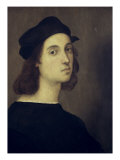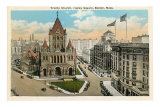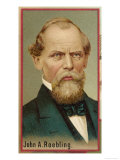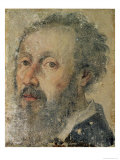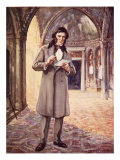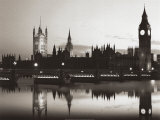|
|
|
|
Raphael
b. 3-28-1483; Urbino, Marche, Italy
d. 4-6-1520: Rome
Italian Renaissance painter Raphael was appointed the architect of the new St. Peters with the death of Bramante in 1514, though his work was demolished or altered by Michelangelo. Raphael also suggested that the destruction of ancient monuments be halted and proposed an organized visual survey of the city to record all antiquities.
• Great Artists of the Italian Renaissance 6 DVD set - The Teaching Company
|
|
|
|
Henry Hobson Richardson
b. 9-29-1838; St. James Parish, Louisiana
d. 4-27-1886; Brookline, Massachusetts (Bright's Disease)
H. H. Richardson is best remembered for his style known as Richardsonian Romanesque, a revival of medieval Romanesque architecture. Richardson's style is embodied in Trinity Church, Boston characterized by symmetrical layout, massive walls and piers, round arches, groin vaults, large towers and decorative blind arcades.
Boston Trinity Church and Richardson are featured in the PBS program 10 Buildings the Changed America
FYI - Richardson was the great grandson of scientist and philosopher Joseph Priestley.
|
|
|
|
John Augustus Roebling
b. 6-12-1806; Mühlhausen, Kingdom of Prussia, Germany
d. 7-22-1869; Brooklyn Heights, NY
John Roebling was famous for the design of the Brooklyn Bridge which spans the East River between Manhattan and Brooklyn. When the Brooklyn Bridge was completed in 1883, it was the first steel-wire suspension bridge in the world as well as the largest suspension bridge.
The bridge construction was supervised by Washington Roebling, the son of John, after the senior Roebling's death. Later Washington Roebling was stricken with caisson disease and his wife, Emily Warren Roebling, saw the bridge to completion.
• The Great Bridge: The Epic Story of the Building of the Brooklyn Bridge
|
|
|
|
Giulio Romano
b. 1499; Rome, Italy
d. 11-1-1546; Mantua
Giulio Romano is best remembered for his style of Renaissance classicism that became known as Mannerism emphasizing “artificial” ideals as opposed to naturalistic qualities of da Vinci and Raphael.
A trivia point for you - Romano was the “only Renaissance artist to be mentioned by William Shakespeare. In Act V, Scene II of The Winter's Tale Queen Hermione's statue is by “that rare Italian master, Julio Romano”, although Giulio was not a sculptor.”
|
|
|
|
John Ruskin
b. 2-8-1819; London, England
d. 1-20-1900; Brantwood, Coniston, England
John Ruskin, an art and social critic, was extremely influential writer in the Victorian and Edwardian eras, espousing that art, and therefore architecture, express the values of a society. Ruskin said the ‘Decorated Gothic’ style was the highest form of architecture yet achieved, from the soaring spires to gargoyles.
The Clock Tower (Big Ben) and the Houses of Parliament, designed in 1837 by Barry and Pugin, reflect Gothic Revival style as opposed to the Neo-classical adopted by the fledging United States to represent democracy.
Ruskin's first work, The Poetry of Architecture, was a “study of cottages, villas, and other dwellings which centred around a Wordsworthian argument that buildings should be sympathetic to their local environments, and should use local materials”.
Ruskin, who gave away most of his inheritance to founding a charity and funding housing reform, saw his theories about social justice influencing the development of the British Labour party and of Christian socialism. He could also be considered an environmentalist.
see Patrick Geddes
John Ruskin quotes ~
• “A book worth reading is worth buying.”
• “An unimaginative person can neither be reverent or kind.”
• “The purest and most thoughtful minds are those which love color the most.”
• “Civilization is the making of civil persons.”
• “Education is the leading of human souls to what is best, and making what is best out of them.”
• “All violent feelings have the same effect. They produce in us a falseness in all our impressions of external things, which I would generally characterize as the pathetic fallacy.”
• “An architect should live as little in cities as a painter. Send him to our hills, and let him study there what nature understands by a buttress, and what by a dome.”
• “The exaltation, the, sin, and the punishment of Tyre have been recorded for us, ...” ~ The Stones of Venice
• Mountainous Landscape by John Ruskin
• Great Thinker Quote- John Ruskin
• The Seven Lamps of Architecture, John Ruskin
• Praeterita (autobiography), John Ruskin
|
|
|
previous page | top | next
architecture | architects list | a | b | c | d-e-f | g | h | i-j | k-l
| m | n | o-p | R | s | t-v | w-x-y-z
|
|
I have searched the web for visual, text, and manipulative curriculum support materials - teaching posters, art prints, maps, charts, calendars, books and educational toys featuring famous people, places and events - to help teachers optimize their valuable time and budget.
Browsing the subject areas at NetPosterWorks.com is a learning experience where educators can plan context rich environments while comparing prices, special discounts, framing options and shipping from educational resources.
Thank you for starting your search for inspirational, motivational, and educational posters and learning materials at NetPosterWorks.com. If you need help please contact us.
|
|
|










